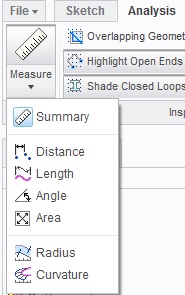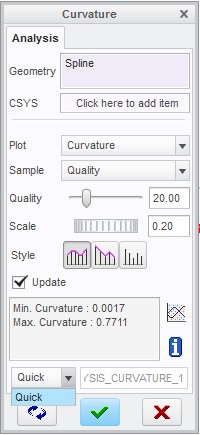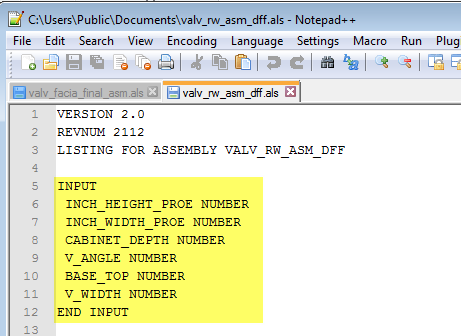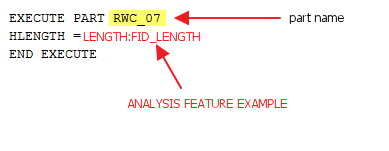Community Tip - Need to share some code when posting a question or reply? Make sure to use the "Insert code sample" menu option. Learn more! X
- Community
- Creo+ and Creo Parametric
- System Administration, Installation, and Licensing topics
- propagate attributes into other part
- Subscribe to RSS Feed
- Mark Topic as New
- Mark Topic as Read
- Float this Topic for Current User
- Bookmark
- Subscribe
- Mute
- Printer Friendly Page
propagate attributes into other part
- Mark as New
- Bookmark
- Subscribe
- Mute
- Subscribe to RSS Feed
- Permalink
- Notify Moderator
propagate attributes into other part
hello all,
what's your favorit way to share an attribute into another model?
let me explain:
in a skeleton, I have defined several attributes and dimensions that are necessary to use in the other components.
I can make a copy of geometry, lenght analysis saved in the tree model to reuse the information, but it's very hard to use.
in fact, instead of a copy of geometry, I would like to make a copy of attributes!
thanks for answering,
Ronan
This thread is inactive and closed by the PTC Community Management Team. If you would like to provide a reply and re-open this thread, please notify the moderator and reference the thread. You may also use "Start a topic" button to ask a new question. Please be sure to include what version of the PTC product you are using so another community member knowledgeable about your version may be able to assist.
Solved! Go to Solution.
- Labels:
-
General
Accepted Solutions
- Mark as New
- Bookmark
- Subscribe
- Mute
- Subscribe to RSS Feed
- Permalink
- Notify Moderator
Hi all,
finally this is the tip I used:
in the first part I create attributes associated to a sketch curve. These attributes are controled by a relation like:
BASE:CRV_ATTRIBUTES=BASE
with BASE is the name of the attribute and ATTRIBUTES is the name of the curve.
then on the other parts I add a copy of this geometry and I specify the reverse relation:
BASE=BASE:CRV_ATTRIBUTES
and it works!
thank to all for your answers ![]()
- Mark as New
- Bookmark
- Subscribe
- Mute
- Subscribe to RSS Feed
- Permalink
- Notify Moderator
Have you tried using a layout?
- Mark as New
- Bookmark
- Subscribe
- Mute
- Subscribe to RSS Feed
- Permalink
- Notify Moderator
I just re-read your question. You want to copy analysis features, etc. in that case an inheritance feature could be useful, depending on what features you want copied over. But I don't know if you would want to copy all of the features over from another model...perhaps therein lies the nature of your question? I guess I'm not sure what you are trying to do, exactly.
- Mark as New
- Bookmark
- Subscribe
- Mute
- Subscribe to RSS Feed
- Permalink
- Notify Moderator
hello Eric,
thank you to answer. The inheretance feature is not so a bad thing. But now I'm shure I was not clear; please try to understand with this example:
create a part, then its symmetric part. You will show all attributes. Modify or add a new attribute in the master model, there is no change on the DEPENDANT (!!!) symmetry.
the other use case is in a model, I would like to reuse the lenght information of a sketch in the assembly using this part. I easily can do it with a relation like
length=TOTAL_LENGTH:FID_217:0
with FID means the feature analysis in the model. But it creates external references
- Mark as New
- Bookmark
- Subscribe
- Mute
- Subscribe to RSS Feed
- Permalink
- Notify Moderator
As far as I know your only options are to continue to do it the way your are, or to use Layouts(Notebooks, they changed the name in Creo 2.0). Either way you will have external references. The way I understand what you are doing you want one part to control the feature of another, there is no way to do that without external references. I could be wrong though, I certainly don't know everything about Creo so there may be other ways to do this. I am very interested to see what others have to say about this, and I anticipate learning some new things based on this discussion.
- Mark as New
- Bookmark
- Subscribe
- Mute
- Subscribe to RSS Feed
- Permalink
- Notify Moderator
thank you James. I think also Eric was talking about the old layout feature, and may be is the best answer for my issue.
I did not practice it a lot, and before testing I would like to know if the notebook can
- manage several 3D with the same attribute
- be managed by 3D attributes, then be shared in another 3D?
example: the notebook have a HEIGHT and LENGTH attributes that control 3 3D models. In other hand, a 3D model have a length analysis feature and I would like to show it in the notebook and reuse it in another model.
- Mark as New
- Bookmark
- Subscribe
- Mute
- Subscribe to RSS Feed
- Permalink
- Notify Moderator
For those who haven't used them: Think of layouts as a cocktail napkin sketch with values you can reference wherever you need them.
A layout is a repository for numerical values that can also have 2D non-parametric sketches and dimensions and notes to better capture the meanings for those values. A layout can be referred to by as many files as you like, there is no limitation there.
I'm not sure the reverse is true - I think that a value on a layout cannot be driven from another part. Check the help files. I'd be happy to be wrong.
Layouts are a good way to provide common values for related items - one could create a typical box assembly of top and bottom plates, side plates, and internal frame pieces and drive their dimensions from a layout so that all the dimensions are coordinated - a top down method. The layout and it's reference sketches are built ahead of any parts and the parts referring to it can be built in any order by any number of workers and still be sure to fit together. An advanced form includes adding named datum references to the sketches that can drive automatic assembly for similarly named items.
The layout sketches are also good for emphasizing small dimensions that are in large parts and assemblies. Because the sketches are non-parametric, there is no need to sketch to scale. Again, they are a good top-down method for depicting details that can otherwise be overlooked because of their small size.
I am fuzzy on tolerances for dimensions in parts that are driven from the layouts. For some reason, I think they share the tolerances, requiring them to be basic and apply tolerances via feature control frames in order to have different tolerances in different models that use the same layout dims.
- Mark as New
- Bookmark
- Subscribe
- Mute
- Subscribe to RSS Feed
- Permalink
- Notify Moderator
A notebook will have parameters, datums, and references that get "published" to anything (assemblies, parts) that you declare. For example, suppose I have the following three parameters in my notebook: length, width, and height. If I declare the model of a cube to the layout, those three parameters now become available at the part level and update based on values in the notebook if I create a relation for each dimension back to the layout parameter (i.e. d1=length, as if the parameter exists in the model).
The problem in your case is that you want the value of an analysis feature to be propogated to all declared models and assemblies as if it is the notebook. I don't think you can do this; perhaps somebody else knows better. You might be able to create a "case study" that a notebook can reference but that depends on what kind of analysis you are doing. A case study is basically a parametric sketch with relations and constraints that a notebook will follow. But i don't see an analysis being feasible unless it's something that can be expressed as code in a relation or as a parametric sketch.
- Mark as New
- Bookmark
- Subscribe
- Mute
- Subscribe to RSS Feed
- Permalink
- Notify Moderator
Ok, so I tried a case study to see what additional capabilities you can have. There are some analysis tools available. So as long as your analysis can work within a parametric 2D sketch with the following analysis tools then you should be good:

- Mark as New
- Bookmark
- Subscribe
- Mute
- Subscribe to RSS Feed
- Permalink
- Notify Moderator
Nevermind; I spoke too soon. Looks like there's no way to save the analysis to the case study. ![]()

- Mark as New
- Bookmark
- Subscribe
- Mute
- Subscribe to RSS Feed
- Permalink
- Notify Moderator
There is another option for using an analysis feature, but it only works if the feature is in a assembly then pushed down to the parts. To do that you would us model inputs. You have to create a parameter in the part file that the analysis will drive, then specify in the parts programing that the parameter will be driven by an input.
To do that open the programing of the part and specify the driven parameter as an input.
Then in the assembly write an execute statement for the part to be controled.

Execute statements need to be written after the "relations" portion of the programing and before the "model" information.
Again this only works if the analysis feature is in the assembly and being pushed to a lower level part.
- Mark as New
- Bookmark
- Subscribe
- Mute
- Subscribe to RSS Feed
- Permalink
- Notify Moderator
Hi all,
finally this is the tip I used:
in the first part I create attributes associated to a sketch curve. These attributes are controled by a relation like:
BASE:CRV_ATTRIBUTES=BASE
with BASE is the name of the attribute and ATTRIBUTES is the name of the curve.
then on the other parts I add a copy of this geometry and I specify the reverse relation:
BASE=BASE:CRV_ATTRIBUTES
and it works!
thank to all for your answers ![]()





